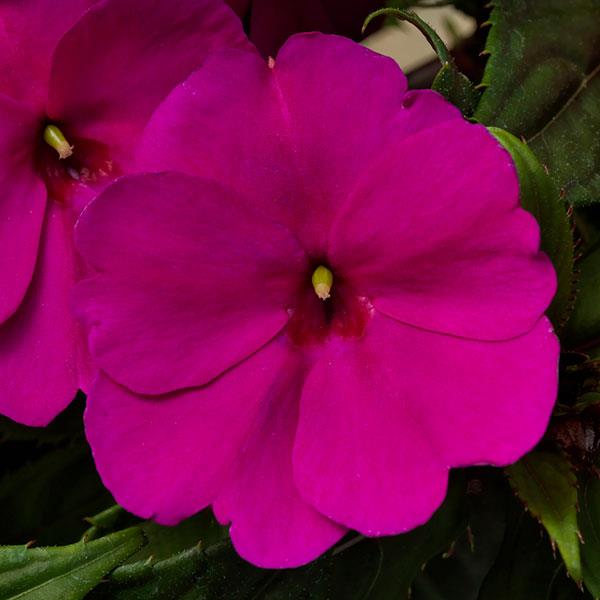Impatiens, Sunpatien Compact Purple
$8.99
Plant, Zone 9+
Discount per quantity
| Quantity | 3 - 8 | 9 - 14 | 15+ |
|---|---|---|---|
| Price | $8.72 | $8.45 | $8.09 |
| % Discount | 3% | 6% | 10% |
Description
SunPatiens Compact Purple: A Burst of Royal Color for Every Garden
Welcome to the World of SunPatiens
Few flowers brighten a space the way SunPatiens do. They greet us with a glow that feels almost electric. The Compact Purple variety takes that sparkle and paints it in deep, velvety violet. You can tuck it into a patio pot, spill it over a raised bed, or weave it through a sunny border. Wherever it lands, it turns heads. In other words, this is a flower that refuses to whisper. It sings.
But most of all, it makes life simpler for all of us who love color but cannot fuss over fragile plants. SunPatiens thrive in full sun, shrug off heat, and keep blooming until true frost. They reward steady care with season-long beauty and never ask for special tricks. Let us explore how you and I can enjoy—and easily care for—this purple gem.
Description: What Makes SunPatiens Compact Purple Special?
A Compact Frame with Giant Impact
SunPatiens Compact Purple stays neat, usually reaching 14–24 inches tall and spreading 16–20 inches wide. The shape is mounded but tidy, making it perfect for containers and tight garden pockets. Because the plant keeps a balanced outline, you do not need constant pruning. Instead of stretching, it fills out, creating a plush cushion of color.
Blossoms of Royal Velvet
Each five-petaled bloom glows like polished amethyst. The petals are broad, overlapping, and hold a subtle sheen that catches morning sun and evening light. New flowers keep pushing up from strong stems, so spent blooms hide quickly beneath fresh ones. After more than a few weeks, you will notice that the plant still looks clean—no endless deadheading required.
Bold Foliage That Frames the Show
Deep green leaves form the perfect back-drop. They are lance-shaped, slightly serrated, and glossy. The rich foliage color makes the purple petals pop even more. In hot weather the leaves do not scorch. They hold their firmness through long summer days, giving the plant a healthy look from the inside out.
Built-In Weather Tolerance
Compact Purple belongs to the SunPatiens series, bred by crossing tropical New Guinea impatiens with wild species that can handle stronger light. That blend means the plant stands up to heat, humidity, and changing weather better than standard impatiens. It will bloom in part shade, but it truly shines in six or more hours of direct light.
Why Choose Compact Purple? Garden Design Ideas
- Container Thrillers
- Set one plant in the center of a 12-inch pot and circle it with trailing sweet potato vine or silver dichondra.
- For a larger patio bowl, group three Compact Purples and edge with white alyssum for contrast.
- Border Color Bands
- Plant in a ribbon along the front of a mixed shrub bed.
- Repeat every three feet to create a steady purple line that anchors bolder foliage behind.
- Pollinator Stops
- SunPatiens blooms offer easy access to nectar. Add them near herbs like basil or dill and watch bees dart between them.
- Sun-Drenched Mass Plantings
- On a sunny slope, set plants one foot apart. They knit together and smother weeds under their canopy.
- Rain Garden Highlights
- Because SunPatiens tolerate moist soil, they can brighten boggy corners where other annuals fail.
How to Plant SunPatiens Compact Purple
Timing the Move Outdoors
Wait until night temperatures stay above 50 °F (10 °C). Cold snaps stunt growth and dull flower color. If you live in a place with late frosts, keep seedlings inside a bit longer, or use row covers to trap warmth.
Choosing the Right Site
Pick a spot with full sun to light shade. In deep shade the plant survives but loses bloom power. Soil should drain well yet hold some moisture. Sandy loam or compost-rich garden soil works best.
Preparing the Bed
- Loosen Soil to at least 8 inches deep.
- Blend in Compost—about two shovels per square foot. This boosts water retention and adds gentle nutrients.
- Check pH if you can. SunPatiens prefer slightly acidic to neutral soil (pH 6.0–7.0).
Spacing Made Simple
Set plants 12–16 inches apart. The compact habit fills gaps quickly but still needs airflow. Good spacing reduces disease risk and makes each plant look full, not crowded.
Planting Steps
- Dig a hole as deep as the root ball and twice as wide.
- Water the root ball before placing it in the hole.
- Backfill, firming soil around roots.
- Water again to settle soil and remove air pockets.
How to Care for SunPatiens Compact Purple
Light Needs
- Full Sun (6+ hours): Best for dense growth and vivid color.
- Part Sun (4–6 hours): Acceptable, though blooms may be fewer.
- Full Shade: Not advised; stems stretch and flowers thin out.
Watering Wisdom
SunPatiens like steady moisture but hate soggy feet. Instead of daily sprinkles, water deeply:
- In Ground: 1 inch of water per week, more in dry spells.
- In Containers: Check soil daily in high heat. Water when the top inch feels dry. A reservoir pot or drip spike saves time.
Feeding for Endless Blooms
- Mix a slow-release, balanced fertilizer (14-14-14 or similar) into soil at planting.
- Every four weeks, drench with a half-strength liquid fertilizer high in phosphorus (the middle number) to push more flowers.
Pruning and Pinching
The Compact series stays neat without heavy trimming. But if stems ever elongate in midsummer, you and I can pinch the tips by one inch. New side shoots will appear, packing on extra flowers.
Pest Patrol
SunPatiens resist many pests, yet vigilance helps:
- Aphids: Look for sticky residue on leaves. Spray with insecticidal soap in the cool morning.
- Spider Mites: Fine webbing under leaves signals trouble. Mist foliage often, because mites hate humidity.
- Whiteflies: Shake stems; if tiny white insects flutter, trap with yellow sticky cards and use neem oil spray.
Disease Defense
These plants are surprisingly tough. Still, here is a quick checklist:
- Root Rot: Avoid waterlogged soil. Raise containers on feet or add perlite to heavy beds.
- Downy Mildew: Rare in SunPatiens, but ensure airflow and avoid overhead watering late in the day.
Heat and Humidity Handling
Unlike standard impatiens, SunPatiens power through 90 °F days without pausing bloom. Their thick leaves lose less water, so they wilt less. Even so, watering in early morning keeps roots cooler and plants happier.
Overwintering or Saying Goodbye
SunPatiens are annuals in most zones. When frost arrives, blooms turn mushy. You can:
- Compost Defeated Plants to recycle nutrients.
- Take Cuttings six weeks before frost and grow them indoors under bright lights, saving your favorites for next spring.
Propagation: Growing More Purple Magic
SunPatiens are vegetatively protected, so home propagation should be for personal use only. Still, taking cuttings can be fun:
- Snip a 4-inch stem just below a leaf node.
- Remove lower leaves, leaving two at the top.
- Dip the cut end in rooting hormone powder.
- Insert into a tray of moist, sterile potting mix.
- Cover with a clear dome or plastic bag to trap humidity.
- Place under bright, indirect light.
- After two weeks, tug gently; if you feel resistance, roots have formed.
Transplant rooted cuttings into small pots. Pinch the growing tip once to encourage bushiness.
Companion Planting Pairs
- Silver Dust Dusty Miller: Soft, silvery foliage lets the purple blooms glow brighter.
- Lemon Gem Marigold: Yellow daisy flowers create a cheerful contrast and repel some pests.
- Coleus ‘Kong Red’: Broad patterned leaves echo the purple tones and deepen the palette.
- Sweet Alyssum ‘Snow Princess’: Fragrant white clouds weave between impatiens, attracting beneficial insects.
- Blue Salvia Mysty: Tall blue spikes rise above compact mounds, creating a tiered color show.
Instead of planting one note, build a symphony. Height, texture, and fragrance all play their part.
Troubleshooting: Common Problems and Quick Fixes
| Symptom | Possible Cause | Solution |
|---|---|---|
| Leaves curl and look crispy | Under-watering or intense dry wind | Water deeply and mulch soil; move container to less windy spot |
| Pale foliage, weak blooms | Nutrient deficiency | Feed with balanced soluble fertilizer; top-dress with compost |
| Yellow leaves, soggy soil | Over-watering or poor drainage | Let soil dry, check pot drainage holes, add perlite |
| Few flowers, lots of leaves | Too much nitrogen | Switch to high-phosphorus bloom booster |
| Stems stretch, gaps appear | Too little light | Relocate to sunnier site or trim back by one-third to promote branching |
After more than a couple of tweaks, most issues fade, and your plants rebound.
How This Plant Lifts Every Space
SunPatiens Compact Purple is more than a pretty face. It supports pollinators, fills design gaps, and lightens our workload. It teaches patience by blooming day after day, even when summer heat presses hardest. Instead of begging for pampering, it stands strong and keeps sharing color. We get the joy of gardening without the stress of constant rescue missions.
Imagine stepping outside each morning. Purple petals greet you, leaves shine with dew, and bees hum gladly. That simple scene can set a kinder tone for the whole day. Gardens can do that, and this plant is an effortless partner in the process.
Caring Checklist at a Glance
- Sun: 6+ hours for best bloom
- Water: Deep, regular; allow slight surface dry-down
- Soil: Well-drained, fertile, pH 6.0–7.0
- Feed: Slow-release at planting, liquid bloom booster monthly
- Prune: Minimal; pinch if needed
- Pests: Watch aphids, mites, whiteflies; treat early
- Temperature: Heat tolerant; protect from frost
Tape this checklist by your potting bench, and you are ready.
Blossoming Together into Tomorrow
May your SunPatiens Compact Purple grow bold and bright, filling your garden with royal hues and your days with easy joy. As we nurture each bloom, we also tend our own sense of wonder. Here’s to many mornings drenched in purple promise, and to the simple acts of care that make it all possible.
Ever-Radiant Horizons Await
Additional information
| Weight | N/A |
|---|---|
| Options | Starter Plug – 3 count, 4 in. (16.9 fl. oz.) Pot |





